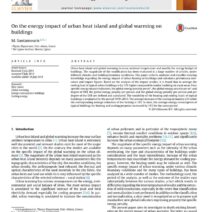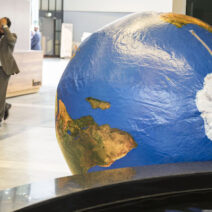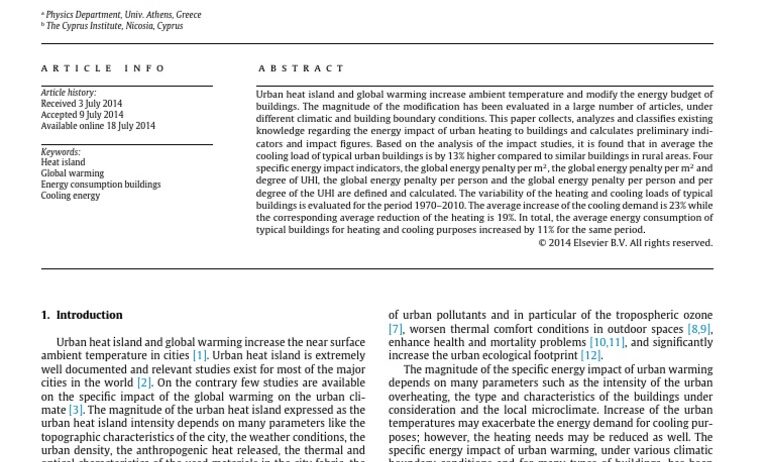The Urban Heat Island (UHI) effect represents a significant environmental phenomenon characterized by urban areas experiencing higher temperatures than their rural surroundings. This temperature disparity primarily results from human activities and infrastructural choices that alter the natural landscape. The question arises: does the UHI effect exacerbate global warming? The interplay between urbanization and climate change presents a complex narrative that warrants in-depth exploration.
The UHI effect manifests itself in various ways, predominantly through the absorption and retention of heat by buildings, roads, and other impermeable surfaces commonly found in urban locales. These surfaces generally possess lower albedo, meaning they are less reflective than natural landscapes. Consequently, they absorb more solar radiation, contributing to elevated temperatures. This phenomenon is particularly pronounced during the day, but it also persists at night, leading to warmer nocturnal temperatures compared to surrounding areas.
To comprehend the implications of UHI on global warming, we must first scrutinize the factors contributing to the UHI effect. The rapid urbanization of the last century has significantly reshaped Earth’s surface. As cities expand, vegetation is often removed, disrupting natural cooling processes. Trees and other plant life play a pivotal role in regulating temperatures through evapotranspiration, a mechanism whereby water is transpired from plant leaves and evaporated from the soil. The loss of such greenery in urban settings catalyzes a local warming effect that contributes to enhanced heat retention.
In addition, anthropogenic activities, including transportation, industrial processes, and energy consumption, release substantial quantities of greenhouse gases. These emissions are not only responsible for increasing global temperatures but also exacerbate the UHI effect. As cities continuously evolve and expand, they become intricate engines of carbon emissions, fueling their own heating. This cyclical relationship raises crucial questions regarding the future of urban centers in the context of climate change.
Moreover, the concept of feedback loops becomes evident when examining the UHI effect’s influence on global warming. The exacerbated temperatures in urban settings can lead to increased energy consumption, particularly for cooling systems during the warmer months. Higher energy demands typically result in greater fossil fuel consumption, which in turn releases more carbon dioxide into the atmosphere. Hence, urban areas may unwittingly intensify the very issues they face through their own heating processes.
Another aspect that deserves attention is the health impacts associated with the UHI effect. Elevated temperatures in urban areas can lead to heat-related illnesses and exacerbate respiratory conditions, particularly among vulnerable populations. As urban heat intensifies, public health systems may become overwhelmed, necessitating increased energy outputs to provide adequate healthcare. This triangular relationship highlights the interconnectedness of urban planning, public health, and climate change, where UHI serves as both a symptom and an aggravator of broader environmental challenges.
Interestingly, addressing the UHI effect might present a dual opportunity. Mitigating UHI could contribuit to alleviating some impacts of global warming. Implementing principles of sustainable urban design, such as increasing green spaces and promoting reflective materials in construction, can significantly temper urban heat. Urban forestry initiatives or green roofs can also enhance evapotranspiration, reintroducing natural cooling processes that combat temperature extremes.
One approach gaining traction is the incorporation of cool roofs and permeable pavements in urban planning. Cool roofs are designed to reflect more sunlight and absorb less heat, thereby reducing heat retention in buildings and surrounding areas. Similarly, permeable pavements allow rainwater to infiltrate the surface, mitigating surface runoff and cooling the environment. These practices not only contribute to reducing UHI effects but also improve urban resilience to flooding and other climate-related challenges.
Moreover, enhancing public transportation systems can curtail reliance on personal vehicles, thereby reducing greenhouse gas emissions while simultaneously minimizing the contribution to UHI. Promoting walkable urban designs encourages communities to engage with their environments sustainably, fostering a culture where climate resilience and health are prioritized.
In conclusion, the Urban Heat Island effect undoubtedly plays a role in exacerbating global warming. Its contribution results from a synergy of urban expansion, energy consumption, and the loss of natural cooling systems. However, there exists a promising avenue toward transformation. By strategically integrating sustainable practices into urban design, it is possible to mitigate UHI effects and, consequently, their contribution to global warming. Thus, a paradigm shift in perspective is required: cities must evolve as proactive agents of climate action rather than passive contributors to the problem. Only then can urban areas harmonize with the environment, safeguarding the planet for future generations. This perspective invites curiosity and underscores the essentiality of a collaborative approach to tackle climate change holistically, emphasizing that the journey toward sustainability begins at our doorsteps.






